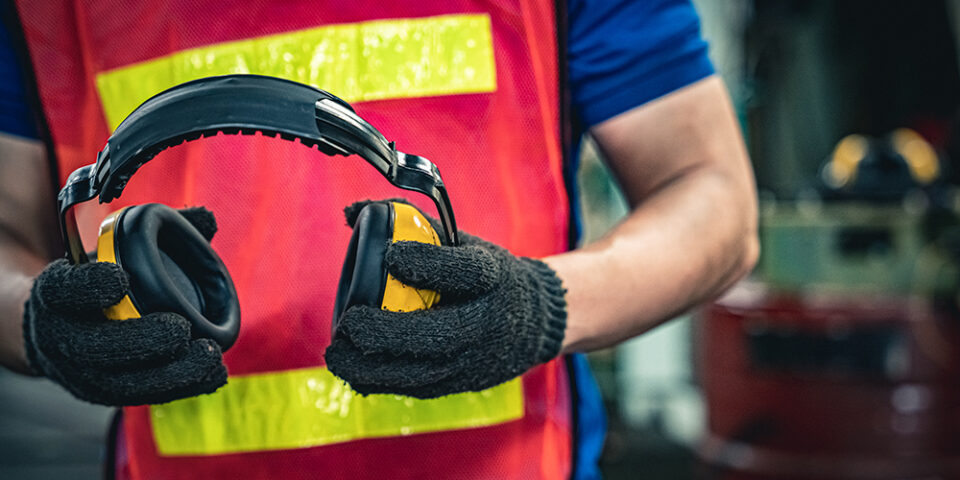Preventing hearing loss at work
You don’t have to work in a factory to be at risk for hearing loss on the job. This common occupational hazard affects millions of workers from musicians to farmers. In fact, hearing loss is the third most common chronic condition after high blood pressure and arthritis in the U.S.
Sandra Hardee, MD, explained what type of noise causes hearing loss and options you have for preventing hearing loss at work.
How loud is too loud?
Decibels are the volume level of sound. Someone whispering will be about 30 decibels. Normal conversation is approximately 60 decibels. Anything above that is approaching a very loud to painful decibel level. For instance, a jet taking off or a rock concert will be within 120 to 140 decibels.
“In a manufacturing plant, it’s very easy to get to a sustained 85 to 90 decibel level, so it’s important to have a good hearing conservation program in place,” Dr. Hardee said. This involves performing annual testing and offering hearing protection.
What does hearing testing involve?
Preventing hearing loss at work begins with understanding whether or not loss has already occurred. The most common hearing test is a pure tone test where an individual sits in an audio booth or a quiet room with headphones and a machine produces a sound at a certain decibel and frequency, and the individual acknowledges whenever they hear the sound. After going through a series of frequencies, the machine produces an audiogram of the person’s hearing.
How do you know if there’s hearing loss?
“Once we get a baseline on someone, then each year we can look for a shift in hearing capability,” Dr. Hardee said. “What we’re looking for is a standard threshold shift. This is a change of 25 decibels or more in an audiometric zone or hertz. We also account for adjustment in age because it’s normal for hearing to decline as we age.”
Sometimes the issue can be non-work related, such as if a person is rides motorcycles or uses firearms. There are also issues that can cause temporary hearing loss, such as impacted earwax or fluid in the middle ear from allergies or an upper respiratory infection. “If someone has an upper respiratory infection, it’s best to wait at least four to six weeks and then repeat the test,” Dr. Hardee said.
What is the impact of hearing loss on quality of life?
Almost all hearing loss is permanent and can have a profound impact on quality of life, far beyond simply causing people to feel left out of conversations.
“They often can’t hear what people are saying and are too embarrassed to ask others to speak louder,” said Dr. Hardee. “They’ll pretend they’re engaged but can’t really understand, so there’s a sense of isolation. That can lead to mental decline which can lead to depression.”
Tinnitus, or ringing in the ears, is another common problem among people with hearing loss. People with tinnitus often have trouble sleeping or concentrating, which can also lead to depression and anxiety. Hearing loss can even become a safety issue. For instance, if you’re trying to walk across the street and can’t hear the traffic.
“There are other effects, such as loss of enjoyment when the sounds we want to hear, such as music or the voice of a loved one, is muted and lacks quality,” Dr. Hardee said. “And there’s data that shows income potential is typically lower for a hearing-impaired worker than a normal hearing individual.”
What can you do when it comes to preventing hearing loss at work?
To find out if the noise in your workspace is hazardous, Dr. Hardee recommended downloading a NIOSH sound level meter app to your smartphone so you can check the decibel level. If you have to raise our voice to speak with someone at arm’s length, then the noise is likely at a hazardous level.
Some ways to reduce your noise exposure include:
- Use quieter equipment and make sure the equipment well maintained and lubricated.
- Enclose the source of the noise or place a barrier between you and the source.
- Reduce your time in noisy areas.
- Beware of chemicals in the area that may be ototoxic to the ear. To reduce exposure, wear a respirator or other protective equipment.
- Wear hearing protection.
“Wearing hearing protective devices is by far the best thing you can do to protect your hearing,” Dr. Hardee said. “This includes earplugs, banded hearing protectors and earmuffs. You can even use double hearing protection such as earplugs with earmuffs for extra protection, particularly if you work a loud manufacturing setting or if there’s a change in your hearing test.”
If you are listening to music or something else while you work, be sure to keep the volume at a safe level and only listen in areas that are not noisy.
You deserve a safe and healthy workplace
We help employers improve the health and wellness of their workforce by offering a variety of services that can be tailored to meet their needs.
Learn More

